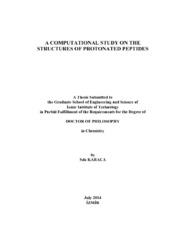Please use this identifier to cite or link to this item:
https://hdl.handle.net/11147/4245Full metadata record
| DC Field | Value | Language |
|---|---|---|
| dc.contributor.advisor | Elmaci Irmak, Nuran | - |
| dc.contributor.author | Karaca, Sıla | - |
| dc.date.accessioned | 2014-12-05T12:48:10Z | - |
| dc.date.available | 2014-12-05T12:48:10Z | - |
| dc.date.issued | 2014-07 | - |
| dc.identifier.uri | http://hdl.handle.net/11147/4245 | - |
| dc.description | Thesis (Doctoral)--İzmir Institute of Technology, Chemistry, İzmir, 2014 | en_US |
| dc.description | Includes bibliographical references (leaves: 108-113) | en_US |
| dc.description | Text in English; Abstract: Turkish and English | en_US |
| dc.description | Full text release delayed at author's request until 2017.08.13 | en_US |
| dc.description.abstract | The reliable protein identification can be achieved by the knowledge of the structures and fragmentation mechanisms of gas-phase peptide fragment ions. Depending on the size and variety of amino acids in the peptide sequence, the probable structures of b-type fragments have been proposed as an acylium, a diketopiperazine, and an oxazolone structures. Recently, a macrocyclic structure has also been reported in the literature for larger b ions (b4 and greater). The macrocyclic structure is one of the problems for determining the correct sequence of peptides because original primary peptide structure is lost. Another problem is the unclear structure of the fragment ions depending on the peptide size and type. In such cases, the databases which are used with the MS/MS results will be insufficient to identify peptide/protein. In this thesis, the structures of peptide bn + ions having different size and type with a sequence of XAAAA, AAXAA and AAAAX (where A is Ala and X is Asn, Asp, Leu, Phe, Tyr or Cys) have been analyzed by using computational methods. The results showed that, the macrocyclic structure is more favorable than linear oxazolone structure for all b5 + ions studied in this work. The proton prefers to be on the oxygen atoms in the macrocycle while it likes to be on the nitrogen atom for the corresponding linear isomer. However, histidine containing b5 + ions do not obey this observation, for those, proton always is found on the nitrogen on the side chain of histidine. There is no significant position effect of amino acid residue for those b5 + ions, the energies of the most of the linear isomers with different position are very similar. Additionally, the proton affinity calculations have also been carried out to explain intensities of PX (where P is Pro and X is Ala, Phe, Asp, Trp or His) and AAAA fragment ions in the mass spectra. The results demonstrated that the mass spectrum consist of both PX and AAAA fragments were in competition with each other, this is explained by the proton affinity calculations. | en_US |
| dc.description.sponsorship | TÜBİTAK (project no: 111T935) | en_US |
| dc.language.iso | en | en_US |
| dc.publisher | Izmir Institute of Technology | en_US |
| dc.rights | info:eu-repo/semantics/openAccess | en_US |
| dc.subject | Density functional theory | en_US |
| dc.subject | Protonated peptide | en_US |
| dc.subject | b ions | en_US |
| dc.subject | Proton affinity | en_US |
| dc.subject | Mass spectrometry | en_US |
| dc.title | A computational study on the structures of protonated peptides | en_US |
| dc.title.alternative | Protonlanmış peptitlerin yapıları üzerine hesapsal bir çalışma | en_US |
| dc.type | Doctoral Thesis | en_US |
| dc.institutionauthor | Karaca, Sıla | - |
| dc.department | Thesis (Doctoral)--İzmir Institute of Technology, Chemistry | en_US |
| dc.relation.publicationcategory | Tez | en_US |
| item.openairecristype | http://purl.org/coar/resource_type/c_18cf | - |
| item.grantfulltext | open | - |
| item.cerifentitytype | Publications | - |
| item.fulltext | With Fulltext | - |
| item.openairetype | Doctoral Thesis | - |
| item.languageiso639-1 | en | - |
| Appears in Collections: | Phd Degree / Doktora | |
Files in This Item:
| File | Description | Size | Format | |
|---|---|---|---|---|
| 10013225.pdf | DoctoralThesis | 8.42 MB | Adobe PDF |  View/Open |
CORE Recommender
Page view(s)
168
checked on Nov 18, 2024
Download(s)
134
checked on Nov 18, 2024
Google ScholarTM
Check
Items in GCRIS Repository are protected by copyright, with all rights reserved, unless otherwise indicated.